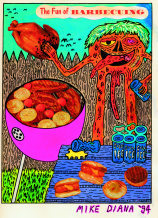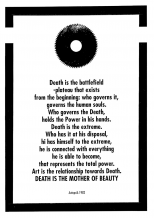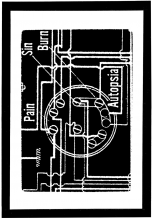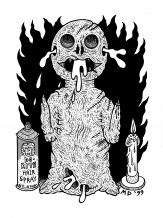| Zeitschrift Umělec 2002/4 >> Uniform future (part 1) | Übersicht aller Ausgaben | ||||||||||||
|
|||||||||||||
Uniform future (part 1)Zeitschrift Umělec 2002/401.04.2002 Keiko Sei | theme | en cs |
|||||||||||||
|
C3 Foundation and Mücsarnok put on an ambitious exhibition this year entitled VISION — Image and Perception for the opening of Hungary’s Budapest Autumn art festival. Its intention was to explore how we understand our inner vision, and how we perceive our outer vision by examining art, science and technology as seen throughout the history of art. A 16th-century painting of Narcissus opens the exhibition and it wraps up with Harun Farocki’s video document on automated eyes, i.e. cameras embedded within precision Gulf War missiles. We come to understand the consequences of human obsession with “our” vision, controlling it and the world through it; the result is chilling.
Participating artists János Sugár and Balázs Beöthy, who are keen on integrating new (and old) media theory into their art practice, said I should go check out a small exhibition at Liget Gallery and meet one of the artists, Miklós Erhardt. So I did. The exhibition turned out to be a reconstruction of the office of an leftwing Italian group. The atmosphere was constructed to resemble an activist club. The photos and videos on display in the gallery were by Senza Frontiere Cooperative and Torino Disobbedienti. A statement by the artists, Dominic Hislop and Erhardt, describes the “social purpose of the exhibition” as offering information through a specific example about the activities of current social movements in Italy. While viewing the show I suddenly flashed back to a scene of police abuse against Italian and Spanish leftists I personally witnessed during the Sept. 2000 IMF/World Bank meeting in Prague. After speaking with Erhardt, I realized that I this experience had to be written. It was all the more urgent as accurate information had never been revealed about what really happened during the IMF/WB conference. A real “face” had to be put to Italian and Spanish leftist groups to rectify the faceless monster image conceived by the authorities and media for the IMF/WB meeting, and now for the NATO summit in Prague. On 25 September 2000, I was traveling by train from Munich to Prague. This was a busy time for me, hopping from one city to another throughout various countries, and now I was going home to Prague only to prepare for a lecture in Hannover. I knew exactly what I was heading into, and what I could expect in Prague. I would be arriving halfway through the IMF/WB week, and activists from all over the world were gathering in the city for the so-called S26 meeting.1 Security at the border was the tightest I had ever seen it. Although I was curious to witness the big event, I had only a couple of hours to get ready for my next trip, so I told myself that I would stay out of it. In order to ensure a safe border crossing, I chose a compartment with no activist types in it, just one old man. I got up to go to the bathroom. I was away for only five minutes, but of course when I got back to the compartment the old man was gone and there were three young Spaniards reclining on the seats. “Oh no,” I thought, “this is exactly what I wanted to avoid.” I sat down but didn’t speak to them. But my determination was shattered a short time later as they began to bombard me with questions like where I was from and where I was going. So we embarked on a long conversation. As I had suspected, along with everybody else on the train, they were Spanish students heading to the demonstration in Prague. They were not, however, activists from the so-called Black Bloc2, but only college students (from a city I’d never heard of) who only wanted to see what was happening in Prague and maybe get a chance to report on it for a college newspaper. They seemed uninformed about any of the border incidents, the tight security and all the tactics and strategies the authority had used in previous days against lefties. They were thus totally unprepared for the trouble to come. “They’ll never let you in like this,” I told them, noticing their Economist magazine and cameras. They looked surprised and asked, “Really?” “Really.” So I started giving them instructions on how to get across the border by taking on new identities. Ok, they were now students of literature going to see the square recently named after Kafka, the Franz Kafka Square. “Kafka!” one of the students asked, scribbling down everything I said. “He’s a painter, no?” “Writer. And what about Havel?” “President...?” The “training” continued. “You will stay at Hotel Olšanka.” They took that down too. “Olšanka is in the neighborhood of Žižkov.” The border was approaching. “So, guys, I must disappear from here. I can’t afford to get caught with you today. Please understand.” I went to the buffet car. The border control and customs officials, as well as the train conductor, came in one after another and checked all my documents. They moved on. I saw from the window a whole train stopped at the border. I went back to the compartment. My Spaniards were delighted. “It worked! It was no problem, very easy, we will buy you a drink in Prague!” We were laughing and cheered up immediately. Ten minutes later the train conductor came back to the compartment, this time with a man who was introduced as “special train police.” The conductor told the Spaniards that this man wanted to see their train tickets. In my hundreds and hundreds of train journeys all over Eastern Europe, and even in Western Europe, I’d seen many police officers, but never anyone calling himself “special train police” wearing a dubious, unidentifiable, almost hastily thrown together, plastic uniform with a dark blue jumper, no decorations, no identifications. The so-called “special train police” then looked at the tickets of the Spaniards and said, “These are fake tickets.” The students were stunned, and didn’t know what to say. “A representative of you must come to the next car,” they told them, so the oldest of the students was taken away. The whole charade was a trap to frame the Spaniards. How could they have passed through every country from Britain to Germany with the same tickets without being accused of having false tickets, except in the Czech Republic. And even if the tickets were fake, why would the official conductor need a “special train police” and why would they have to take one of them to another car? Now I was getting angry, very angry, so angry that I went into the next car. When I opened the door what I saw was a poor student, shaking with fear and incomprehension, surrounded by five men in uniforms: the conductor, the so-called “special train police,” and three armed anti-terrorist police. They were writing down the kids’ passport numbers, telling him that they would report the crime to the Spanish embassy in Prague. The shaken student explained to them that they bought the tickets at a British Railways in London and the tickets were completely legal. The stone-faced conductor demanded payment for new tickets in the Czech Republic. I approached and demanded that the “special train police” show his identification. The conductor stepped in front him and shouted at me, “Don’t try to be smart, okay!” I said I was a journalist and would write about everything I witnessed here. One of the anti-terrorist squad pierced me through with his eyes. Somehow, I found myself thrown headfirst into the dispute. When we finally got back to the compartment, the student looked so down. There was a new companion in our compartment: a German leftist from Düsseldorf. He explained to us that he’d been turned back at the border when he tried to get into the country by bus the previous day. This time he was trying the train, only with a ticket to Plzeň and not to Prague. The trick worked and he got through. While I was listening to this, two of the anti-terrorist squad came back. This time they demanded to see my passport. They started to write down my passport number and one of them told me that they would report this to the Japanese embassy. But a moment later the other one said, “No, we won’t report it, don’t worry.” Classic communist police technique, one pistol-whips you and the other gives you a cigarette. The Spaniards were more shocked by this incident than I was, and they begged the police not to do it. “This lady has nothing to do with our trouble; she just helped us.” It was sweet of them. The anti-terrorists left. The Spaniards were so apologetic that they started to talk about themselves: I’m a student of this and that; I’m 20 years old… The youngest was 18. He’d attended a few communist meetings, because he was curious about it in Basque, his native country, he said. “Basque!?” I leapt off the seat. “Why didn’t you tell me. A potential leftist and a potential terrorist are two very different things; now I’m even involved with a potential terrorist in the authority’s eyes!” He shied away, and said, “But... but I don’t say I’m a Basque the first time I meet somebody, just like that.” Maybe he was right. I calmed down. But in my imagination I created a feature story for the authority’s sake: An American boy was staying in my flat while I was away. He was working an independent radio station for the IMF/WB protest, and I knew that he was going out with a high-profile personality from one of the main anti-globalization groups, whose Prague office was regularly tapped. Now the police could match my record to the address where I was hosting these people. And now the icing on the cake: I was traveling with Spanish leftists and a Basque terrorist. The main material the police use when constructing a possible scenario while investigating a person is to match up all records and information on this person; and this is exactly how an innocent citizen is framed. An image of Katherina Blum, the proud young woman from the novel by Heinrich Boll whose privacy and honor are destroyed by the yellow press and the police, swam through my imagination. After all, a record is all the authorities need, regardless of facts. Now it slowly began to sink in why the IMF/WB meeting was taking place in Prague. The record. Now that Europol was getting itself established and networked, they needed to stockpile a list of existing leftists and terrorists, as well as potential leftists and terrorists. All they had to do was record everyone coming into the Czech Republic during this period. This way they didn’t have to travel all around Europe to collect the names. While doing this, the brand new FBI office in CZ, Interpol and the Europol could bring former communist police officers up to “Western” standards. (Prior to the IMF/WB the Czech police were sent to Washington DC for training by the Washington police department, which had successfully smashed down previous IMF/WB protesters with dozens of cases of human rights abuse). I asked the German to tell me about his situation once again. He said the police had accused him of using a fake passport when they turned him back. While we were talking in the corridor a woman approached us and introduced herself as a journalist working for Reuters. “I overheard your conversation and am interested to hear more about what happened to you. I’m collecting stories like yours.” So we told her all that happened to the German guy and to the Spaniards. The Spaniards were too afraid to give her their names. We all got off at the main train station in Prague. The conductor made photocopies of the Spaniards’ tickets, telling them that he would send this to the authority to investigate, which I’m sure he never did. The Spaniards did as they were told and went to the nearest exchange office to change their British Pounds for Czech Koruna in order to pay the conductor for the train ride. The Reuters woman herself inspected their tickets with curiosity. The older German activist promised to take the young Spaniards to an INPEG complaint center to report the case. I now set off for Hannover to give a lecture at the International Frauen Academy, which, incidentally, was on activism. The students were all eager to hear a firsthand report from Prague. I told them what I had seen. After the class I went to see Expo Hannover, a symbol of technology, commerce and the future. On Expo square CNN was blaring news on a giant Jumbotron of a scene from Prague: A couple of beautifully tanned and bandana adorned Latino “activists” were gorgeously smashing the window of a McDonald’s on Wenceslas Square, a scene that looked as iconic as Robert Capa’s photo of a dying Spanish soldier. It broadcast all over the world, and the people who saw it got the impression that downtown Prague was being razed to the ground by Spanish and Italian radicals — an image Czech authorities had been carefully crafting for months. Later I heard from an acquaintance who was in the square at the time of the incident that there was something fishy going on. People were walking around like any other day in the square and most of them didn’t even notice the incident. Questions remain: Why hadn’t this particular McDonald’s, at the very center of Prague and an obvious target for attack, protected its windows? Why there were so many cameras and video cameras waiting at this spot at this very moment? I explained this mystery to several people and collected different opinions. One media theoretician said: “You see, this is what we’ve been discussing for so many years, just as Sontag or Flusser say, the event is created for the sake of the media!” One documentary filmmaker said: “We heard that the McDonald’s put up a lot of insurance money.” And one ordinary citizen said: “The Spanish and Italians are terrible; they come to destroy our beautiful Prague.” Conducting an investigation into who was actually there is the business of journalists and investigators. From the point of view of the media, however, it doesn’t make a difference whether Italian activists or police infiltrators smashed the window. The purpose of both groups was to appeal to the wider mass media. This incident was different from a similar mystery in Genoa during the G8 summit when fascist infiltrators posing as leftists overturned the dumpsters of the Independent Media Center;3 this action had to be accomplished in secret. Authorities in Prague, on the other hand, meant to create an image of foreign aggressors wrecking havoc in another land. “The Media Event” thus served its own purpose. Forum 2000 is the annual international symposium hosted by President Vaclav Havel for his high-profile Nobel Prize winning friends. That year the symposium took place shortly after the IMF/WB meeting. During one session a Latino-looking activist was invited to speak for a few minutes. This young man, looking uncomfortable in front of such a large and distinguished audience, stammered out a few sentences about the necessity of using violence if necessary in order to fight big corporate power. Jacques Rupnik, director of Studies at the Center for International Affairs Paris and expert of Central European affairs launched into a slick and professional tongue-lashing on the pride of the Czech people for their history of non-violence: just look at the Velvet Revolution, the violence was brought from abroad, and those that rioted in the streets during the IMF/WB meeting were all foreigners. After the session I caught up with Václav Trojan, long-time veteran of human rights activism, and asked him about the two speeches. He expressed concern for the simplified mythmaking of non-violent Czechs vs. aggressive foreigners. And, yes, the young man didn’t address the message so well, but to accuse foreigners for all the violence in Prague is dangerous. An ironic thorn is lodged at the heart of the mysterious violence in Prague. CNN in one broadcast confused an image of a street in Prague with that of a street in Belgrade, commenting over the Prague scene that events were becoming more and more violent in the Belgrade streets. This was for a report on what would later be known as the nonviolent revolution of Yugoslavia. CNN’s blunder would thus steal praise from Belgrade, which had finally achieved a nonviolent regime change. Perhaps the producers could not imagine a nonviolent image of Belgrade. The automatic image of Yugoslavians must have fallen within the category of frothing beasts. Numerous organizations, NGOs and individual activists arrived in Prague to protest the policies and activities of the IMF and World Bank. Greek Telecommunication Union, Jubilee 2000, Oxfam, Kurdish activists… Of them, maybe the most “sexy” group, as journalists began to refer to them, was Ya Basta! from Italy, who had Zapatista spirit. They looked so consciously photogenic that some believed they were the culprits behind the McDonald’s incident. Dressed in their trademark puffy white hygienic overalls, wearing gas masks and lined up in rows in the street they reminded me of Gilbert Artman’s Urban Sax. Urban Sax is a multidimensional spectacle involving 90 artists. The performers dress up in readily available but surreal costumes of bright-white overalls and masks. The assemblage creates sounds combining nature, religious chanting and industrial noise while using human musical instruments that mingle with the noises of people in the street. They march down the streets freely, apart from one another for a moment, then together again, but all heading in one direction, where cathartic release awaits their arrival. Random people in the street get caught up in this march of appreciation for their city and the daily environment, both during the performance and after, a catharsis. What appears to be spontaneous improvisation in fact takes thorough research into the environment and the architectural and spatial structure of the city before each performance. The performers embrace it as an orchestral continuum and the highest possibly dramatic effect is attained for the audience.
01.04.2002
Empfohlene Artikel
|
|||||||||||||
|
04.02.2020 10:17
Letošní 50. ročník Art Basel přilákal celkem 93 000 návštěvníků a sběratelů z 80 zemí světa. 290 prémiových galerií představilo umělecká díla od počátku 20. století až po současnost. Hlavní sektor přehlídky, tradičně v prvním patře výstavního prostoru, představil 232 předních galerií z celého světa nabízející umění nejvyšší kvality. Veletrh ukázal vzestupný trend prodeje prostřednictvím galerií jak soukromým sbírkám, tak i institucím. Kromě hlavního veletrhu stály za návštěvu i ty přidružené: Volta, Liste a Photo Basel, k tomu doprovodné programy a výstavy v místních institucích, které kvalitou daleko přesahují hranice města tj. Kunsthalle Basel, Kunstmuseum, Tinguely muzeum nebo Fondation Beyeler.
|

































 We Are Rising National Gallery For You! Go to Kyjov by Krásná Lípa no.37.
We Are Rising National Gallery For You! Go to Kyjov by Krásná Lípa no.37.
Kommentar
Der Artikel ist bisher nicht kommentiert wordenNeuen Kommentar einfügen